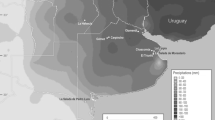Abstract
In order to disentangle the causes of variations in water chemistry among European shallow lakes, we performed standardised sampling programs in 86 lakes along a latitudinal gradient from southern Spain to northern Sweden. Lakes with an area of 0.1 to 27 000 ha and mean depth of 0.4–5.6 m located in low to high altitudes were investigated within the EC project ECOFRAME 1–4 times during June–October 2000–2001. Several variables like conductivity, alkalinity, abundance of submerged plants, concentrations of suspended solids, total nitrogen and phosphorus were latitude-dependent decreasing from south to north. Secchi depth, concentrations of total nitrogen, total phosphorus, suspended solids, and chlorophyll a correlated strongly with the presumed quality classes of the lakes. We came to the conclusion that the variability of shallow lakes in Europe is still mostly dependent on natural differences. Variables connected to lake morphometry, seasonality, basin geology and climate explained altogether nearly half of the total variability of lakes. The trophic state factor, describing mostly the human influence on lakes, was the strongest single factor responsible for nearly a quarter of the total variability of the studied European lakes.
Similar content being viewed by others
References
Arvola, L., 1981. Spectrophotometric determination of chlorophyll a and phaeopigments in ethanol extractions. Annales Botanici Fennici 18: 221–227.
Canfield, D. E. J., J. V. Shireman, D. E. Colle & W. T. Haller, 1984. Prediction of chlorophyll a concentrations in Florida lakes: importance of aquatic macrophytes. Can. J. Fish. aquat. Sci. 41: 497–501.
Cobelas, M. A. & C. Rojo, 1994. Spatial, seasonal and long-term variability of phytoplankton photosynthesis in lakes. J. Plankton Res. 16: 1691–1716.
Duarte, C., S. Agusti & D. E. Jr. Canfield, 1992. Patterns in phytoplankton community structure in Florida lakes. Limnol. Oceanogr. 37: 155–161.
EC Directive 2000/60/EC. Directive of the European Parliament and of the Council of the European Union establishing a framework for community action in the field of water policy. Council of the European Union, Brussels: 66 pp.
Faafeng, B. A. & D. O. Hessen, 1993. Nitrogen and phosphorus concentrations and N:P ratios in Norwegian lakes: Perspectives of nutrient limitation. Verh. int. Ver. theor. angewan. Limnol. 25: 465–469.
Jensen, J. P., P. Kristensen & E. Jeppesen, 1990. Relationships between nitrogen loading and in-lake nitrogen concentrations in shallow Danish lakes. Verh. int. Ver. theor. angewan. Limnol. 24: 201–204.
Kalff, J., 1991. The utility of latitude and other environmental factors as predictors of nutrients, biomass and production in lakes worldwide: problems and alternatives. Verh. int. Ver. theor. angewan. Limnol. 24: 1235–1239.
Maberly, S. C., L. Kling, C. E. Gibson, L. May, R. I. Jones, M. M. Dent & C. Jordan, 2003. Linking nutrient limitation and water chemistry to catchment characteristics. Hydrobiologia 506–509: 83–91.
Mathes, J. I. Korczynski & J. Müller, 2003. Shallow lakes in Northeast Germany – Trophic situation and restoration programmes. Hydrobiologia 506–509: 797–802.
Moss, B., M. Beklioglu, L. Carvalho, S. Kilinc, S. McGowan & D. Stephen, 1997. Vertically challenged limnology; contrasts between deep and shallow lakes. Hydrobiologia 342/343: 267–267.
Murphy, J. & J. P. Riley, 1962. A modified single solution method for the determination of phosphate in natural waters. Analytika Chimica Acta 27: 31–36.
Ott, I., R. Laugaste & T. Kõiv, 1999. Investigations of biodiversity in freshwater ecosystems in Estonia. In Hydrobiological Research in the Baltic Countries. Part I. Rivers and Lakes. Vilnius: 325– 368.
Padisák, J. & C.S. Reynolds, 2003. Shallow lakes: The absolute, the relative, the functional and the pragmatic. Hydrobiologia 506– 509: 1–11.
Schindler, D., 1978. Factors regulating phytoplankton production and standing crop in the world's freshwaters. Limnol. Oceanogr. 23: 478–486.
Vighi, M. & G. Chiaudani, 1985. A simple method to estimate lake P concentrations resulting from natural background loadings. Wat. Res. 19: 987–991.
Author information
Authors and Affiliations
Rights and permissions
About this article
Cite this article
Nõges, P., Nõges, T., Tuvikene, L. et al. Factors controlling hydrochemical and trophic state variables in 86 shallow lakes in Europe. Hydrobiologia 506, 51–58 (2003). https://doi.org/10.1023/B:HYDR.0000008541.36537.51
Issue Date:
DOI: https://doi.org/10.1023/B:HYDR.0000008541.36537.51




